Linglong Dai
RAQ-MIMO: MIMO for Multi-Band Rydberg Atomic Quantum Receiver
Sep 09, 2025Abstract:Rydberg atomic quantum receivers (RAQRs) are capable of receiving multi-band radio-frequency (RF) signals simultaneously, which are expected to break Chu's limit for classical electronic antennas. However, signals from different users will interfere with each other in the optical intermediate frequency (IF) domain of the multi-band quantum receiver, which is termed the IF interference (IFI) problem. To address this problem, in this paper, we propose a multi-input multi-output (MIMO) architecture for Rydberg atomic quantum receiver (RAQ-MIMO) by exploiting the additional spatial diversity of MIMO receivers. Specifically, by applying the dynamic signal model of RAQRs, we clarify the physical relationship between the quantum local oscillator (LO) configurations and the multi-band gains with the concept of quantum transconductance. Then, with the quantum transconductance-based signal model, we formulate the spectral efficiency (SE) maximization problem and further propose the quantum weighted minimum mean square error (qWMMSE) algorithm, which jointly optimizes the quantum LO configurations and the classical precoder/combiner matrices. Furthermore, we test the qWMMSE algorithm within the standard space division multiple access (SDMA) scheme and the frequency division multiple access (FDMA) scheme. Simulation results demonstrate that the qWMMSE optimization framework can significantly improve the SE of RAQ-MIMO systems for both multiple access schemes, and that RAQ-MIMO systems can outperform classical electronic receiver-based multi-user MIMO systems by eliminating the mutual coupling effect between classical antennas.
Near-Field Challenges in Ultra-Wideband ISAC: Beamforming Strategies and System Insights
Aug 26, 2025Abstract:The shift toward sixth-generation (6G) wireless networks places integrated sensing and communications (ISAC) at the core of future applications such as autonomous driving, extended reality, and smart manufacturing. However, the combination of large antenna arrays and ultra-wide bandwidths brings near-field propagation effects and beam squint to the forefront, fundamentally challenging traditional far-field designs. True time delay units (TTDs) offer a potential solution, but their cost and hardware complexity limit scalability. In this article, we present practical beamforming strategies for near-field ultra-wideband ISAC systems. We explore codebook designs across analog and digital domains that mitigate beam squint, ensure reliable user coverage, and enhance sensing accuracy. We further validate these approaches through large-scale system-level simulations, including 3D map-based evaluations that reflect real-world urban environments. Our results demonstrate how carefully designed beamforming can balance communication throughput with sensing performance, achieving reliable coverage and efficient resource use even under severe near-field conditions. We conclude by highlighting open challenges in hardware, algorithms, and system integration, pointing toward research directions that will shape the deployment of 6G-ready ISAC networks.
Decoding for Punctured Convolutional and Turbo Codes: A Deep Learning Solution for Protocols Compliance
Feb 21, 2025Abstract:Neural network-based decoding methods have shown promise in enhancing error correction performance, but traditional approaches struggle with the challenges posed by punctured codes. In particular, these methods fail to address the complexities of variable code rates and the need for protocol compatibility. This paper presents a unified Long Short-Term Memory (LSTM)-based decoding architecture specifically designed to overcome these challenges. The proposed method unifies punctured convolutional and Turbo codes. A puncture embedding mechanism integrates puncturing patterns directly into the network, enabling seamless adaptation to varying code rates, while balanced bit error rate training ensures robustness across different code lengths, rates, and channels, maintaining protocol flexibility. Extensive simulations in Additive White Gaussian Noise and Rayleigh fading channels demonstrate that the proposed approach outperforms conventional decoding techniques, providing significant improvements in decoding accuracy and robustness. These results underscore the potential of LSTM-based decoding as a promising solution for next-generation artificial intelligence powered communication systems.
Large Language Model Enabled Multi-Task Physical Layer Network
Dec 30, 2024Abstract:The recent advance of Artificial Intelligence (AI) is continuously reshaping the future 6G wireless communications. Recently, the development of Large Language Models (LLMs) offers a promising approach to effectively improve the performance and generalization for different physical layer tasks. However, most existing works finetune dedicated LLM networks for a single wireless communication task separately. Thus performing diverse physical layer tasks introduces extremely high training resources, memory usage, and deployment costs. To solve the problem, we propose a LLM-enabled multi-task physical layer network to unify multiple tasks with a single LLM. Specifically, we first propose a multi-task LLM framework, which finetunes LLM to perform multi-user precoding, signal detection and channel prediction simultaneously. Besides, multi-task instruction module, input encoders, as well as output decoders, are elaborately designed to distinguish multiple tasks and adapted the features of different formats of wireless data for the features of LLM. Numerical simulations are also displayed to verify the effectiveness of the proposed method.
Spatio-Temporal Electromagnetic Kernel Learning for Channel Prediction
Dec 23, 2024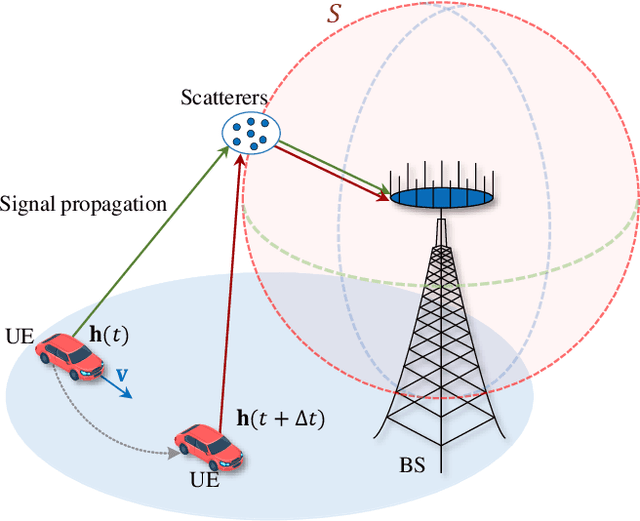
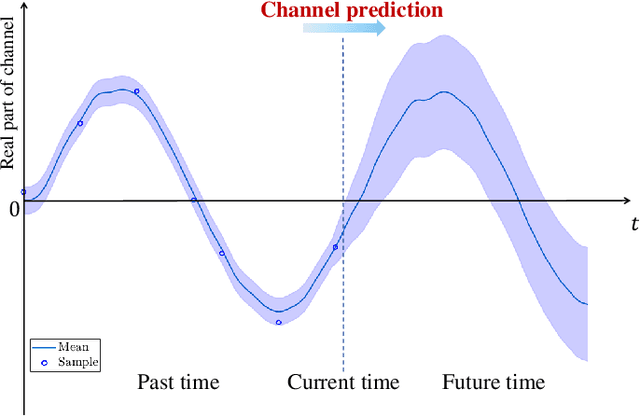
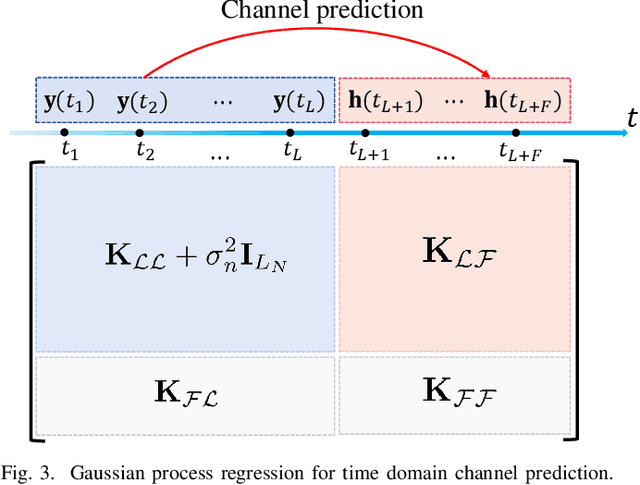
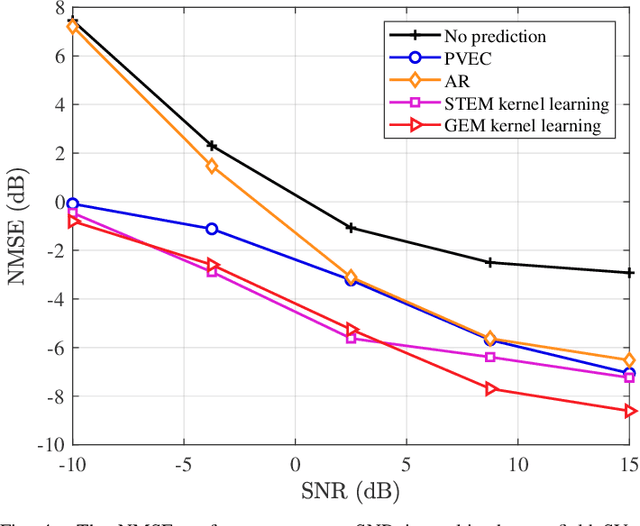
Abstract:Accurate channel prediction is essential for addressing channel aging caused by user mobility. However, the actual channel variations over time are highly complex in high-mobility scenarios, which makes it difficult for existing predictors to obtain future channels accurately. The low accuracy of channel predictors leads to difficulties in supporting reliable communication. To overcome this challenge, we propose a channel predictor based on spatio-temporal electromagnetic (EM) kernel learning (STEM-KL). Specifically, inspired by recent advancements in EM information theory (EIT), the STEM kernel function is derived. The velocity and the concentration kernel parameters are designed to reflect the time-varying propagation of the wireless signal. We obtain the parameters through kernel learning. Then, the future channels are predicted by computing their Bayesian posterior, with the STEM kernel acting as the prior. To further improve the stability and model expressibility, we propose a grid-based EM mixed kernel learning (GEM-KL) scheme. We design the mixed kernel to be a convex combination of multiple sub-kernels, where each of the sub-kernel corresponds to a grid point in the set of pre-selected parameters. This approach transforms non-convex STEM kernel learning problem into a convex grid-based problem that can be easily solved by weight optimization. Finally, simulation results verify that the proposed STEM-KL and GEM-KL schemes can achieve more accurate channel prediction. This indicates that EIT can improve the performance of wireless system efficiently.
AI and Deep Learning for THz Ultra-Massive MIMO: From Model-Driven Approaches to Foundation Models
Dec 13, 2024Abstract:In this paper, we explore the potential of artificial intelligence (AI) to address the challenges posed by terahertz ultra-massive multiple-input multiple-output (THz UM-MIMO) systems. We begin by outlining the characteristics of THz UM-MIMO systems, and identify three primary challenges for the transceiver design: 'hard to compute', 'hard to model', and 'hard to measure'. We argue that AI can provide a promising solution to these challenges. We then propose two systematic research roadmaps for developing AI algorithms tailored for THz UM-MIMO systems. The first roadmap, called model-driven deep learning (DL), emphasizes the importance to leverage available domain knowledge and advocates for adopting AI only to enhance the bottleneck modules within an established signal processing or optimization framework. We discuss four essential steps to make it work, including algorithmic frameworks, basis algorithms, loss function design, and neural architecture design. Afterwards, we present a forward-looking vision through the second roadmap, i.e., physical layer foundation models. This approach seeks to unify the design of different transceiver modules by focusing on their common foundation, i.e., the wireless channel. We propose to train a single, compact foundation model to estimate the score function of wireless channels, which can serve as a versatile prior for designing a wide variety of transceiver modules. We will also guide the readers through four essential steps, including general frameworks, conditioning, site-specific adaptation, and the joint design of foundation models and model-driven DL.
Near-Field Wideband Beamforming for RIS Based on Fresnel Zone
Nov 28, 2024Abstract:Reconfigurable intelligent surface (RIS) has emerged as a promising solution to overcome the challenges of high path loss and easy signal blockage in millimeter-wave (mmWave) and terahertz (THz) communication systems. With the increase of RIS aperture and system bandwidth, the near-field beam split effect emerges, which causes beams at different frequencies to focus on distinct physical locations, leading to a significant gain loss of beamforming. To address this problem, we leverage the property of Fresnel zone that the beam split disappears for RIS elements along a single Fresnel zone and propose beamforming design on the two dimensions of along and across the Fresnel zones. The phase shift of RIS elements along the same Fresnel zone are designed aligned, so that the signal reflected by these element can add up in-phase at the receiver regardless of the frequency. Then the expression of equivalent channel is simplified to the Fourier transform of reflective intensity across Fresnel zones modulated by the designed phase. Based on this relationship, we prove that the uniformly distributed in-band gain with aligned phase along the Fresnel zone leads to the upper bound of achievable rate. Finally, we design phase shifts of RIS to approach this upper bound by adopting the stationary phase method as well as the Gerchberg-Saxton (GS) algorithm. Simulation results validate the effectiveness of our proposed Fresnel zone-based method in mitigating the near-field beam split effect.
A physics-based perspective for understanding and utilizing spatial resources of wireless channels
Oct 08, 2024



Abstract:To satisfy the increasing demands for transmission rates of wireless communications, it is necessary to use spatial resources of electromagnetic (EM) waves. In this context, EM information theory (EIT) has become a hot topic by integrating the theoretical framework of deterministic mathematics and stochastic statistics to explore the transmission mechanisms of continuous EM waves. However, the previous studies were primarily focused on frame analysis, with limited exploration of practical applications and a comprehensive understanding of its essential physical characteristics. In this paper, we present a three-dimensional (3-D) line-of-sight channel capacity formula that captures the vector EM physics and accommodates both near- and far-field scenes. Based on the rigorous mathematical equation and the physical mechanism of fast multipole expansion, a channel model is established, and the finite angular spectral bandwidth feature of scattered waves is revealed. To adapt to the feature of the channel, an optimization problem is formulated for determining the mode currents on the transmitter, aiming to obtain the optimal design of the precoder and combiner. We make comprehensive analyses to investigate the relationship among the spatial degree of freedom, noise, and transmitted power, thereby establishing a rigorous upper bound of channel capacity. A series of simulations are conducted to validate the theoretical model and numerical method. This work offers a novel perspective and methodology for understanding and leveraging EIT, and provides a theoretical foundation for the design and optimization of future wireless communications.
Error Correction Code Transformer: From Non-Unified to Unified
Oct 04, 2024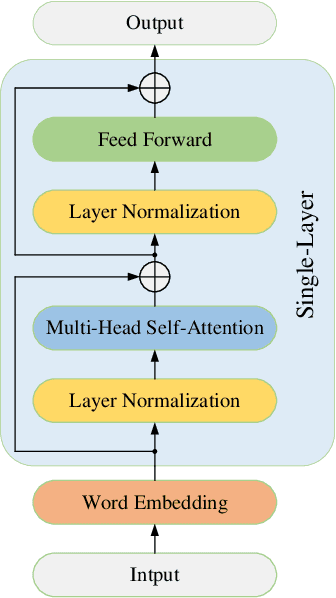

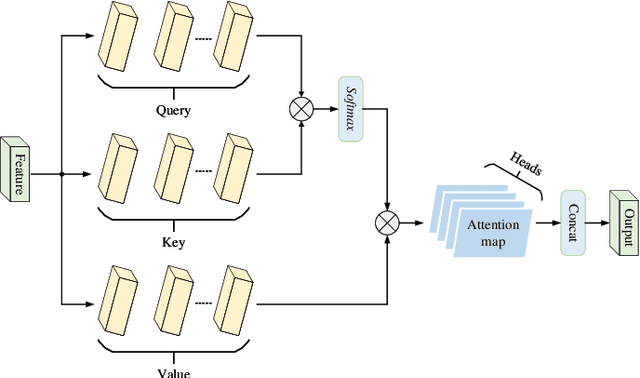

Abstract:Channel coding is vital for reliable data transmission in modern wireless systems, and its significance will increase with the emergence of sixth-generation (6G) networks, which will need to support various error correction codes. However, traditional decoders were typically designed as fixed hardware circuits tailored to specific decoding algorithms, leading to inefficiencies and limited flexibility. To address these challenges, this paper proposes a unified, code-agnostic Transformer-based decoding architecture capable of handling multiple linear block codes, including Polar, Low-Density Parity-Check (LDPC), and Bose-Chaudhuri-Hocquenghem (BCH), within a single framework. To achieve this, standardized units are employed to harmonize parameters across different code types, while the redesigned unified attention module compresses the structural information of various codewords. Additionally, a sparse mask, derived from the sparsity of the parity-check matrix, is introduced to enhance the model's ability to capture inherent constraints between information and parity-check bits, resulting in improved decoding accuracy and robustness. Extensive experimental results demonstrate that the proposed unified Transformer-based decoder not only outperforms existing methods but also provides a flexible, efficient, and high-performance solution for next-generation wireless communication systems.
Coded Beam Training for RIS Assisted Wireless Communications
Jun 22, 2024



Abstract:Reconfigurable intelligent surface (RIS) is considered as one of the key technologies for future 6G communications. To fully unleash the performance of RIS, accurate channel state information (CSI) is crucial. Beam training is widely utilized to acquire the CSI. However, before aligning the beam correctly to establish stable connections, the signal-to-noise ratio (SNR) at UE is inevitably low, which reduces the beam training accuracy. To deal with this problem, we exploit the coded beam training framework for RIS systems, which leverages the error correction capability of channel coding to improve the beam training accuracy under low SNR. Specifically, we first extend the coded beam training framework to RIS systems by decoupling the base station-RIS channel and the RIS-user channel. For this framework, codewords that accurately steer to multiple angles is essential for fully unleashing the error correction capability. In order to realize effective codeword design in RIS systems, we then propose a new codeword design criterion, based on which we propose a relaxed Gerchberg-Saxton (GS) based codeword design scheme by considering the constant modulus constraints of RIS elements. In addition, considering the two dimensional structure of RIS, we further propose a dimension reduced encoder design scheme, which can not only guarentee a better beam shape, but also enable a stronger error correction capability. Simulation results reveal that the proposed scheme can realize effective and accurate beam training in low SNR scenarios.
 Add to Chrome
Add to Chrome Add to Firefox
Add to Firefox Add to Edge
Add to Edge